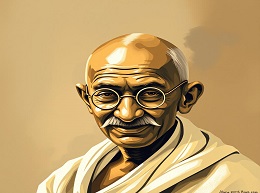The Story of My Experiments with Truth

The Story of My Experiments with Truth: A Journey of Self-Discovery
Mahatma Gandhi’s autobiography, "The Story of My Experiments with Truth," is more than just a recounting of his life. It is a profound journey of self-discovery, detailing the principles and philosophies that guided one of the most influential figures in modern history. This review explores the key themes, personal anecdotes, and timeless lessons that Gandhi offers, illustrating how his experiments with truth can inspire and guide readers in their own lives.
Childhood Influences and Early Lessons
Gandhi’s early years in Porbandar and Rajkot played a significant role in shaping his character and values. From a young age, he was influenced by the moral integrity and simplicity of his parents. His father, Karamchand Gandhi, was a man of principle, while his mother, Putlibai, was deeply religious and devoted to a life of self-discipline and austerity.
Example: The Cherished Memory of Harishchandra
Gandhi recalls being deeply moved by the story of Harishchandra, a legendary king known for his unwavering commitment to truth and duty. This story left an indelible mark on young Gandhi, planting the seeds of his lifelong devotion to truth and righteousness.
Education and Exposure to Western Ideas
Gandhi’s education in India and later in London exposed him to a variety of philosophies and cultures. His time in London, where he studied law, introduced him to Western thought and the works of great philosophers and religious texts, including the Bhagavad Gita, the Bible, and the works of Tolstoy.
Example: The Influence of the Bhagavad Gita
The Bhagavad Gita became a spiritual reference for Gandhi, offering guidance and solace during his periods of doubt and struggle. Its teachings on duty, detachment, and devotion significantly influenced his philosophy of selfless service.
The South African Experience
Gandhi’s two-decade stay in South Africa was a transformative period in his life. It was here that he first experienced racial discrimination and injustice, which propelled him into activism. His work in South Africa laid the foundation for his principles of non-violence (Ahimsa) and civil disobedience (Satyagraha).
Example: The First Act of Civil Disobedience
In 1893, Gandhi was thrown off a train in Pietermaritzburg for refusing to move from the first-class compartment, despite holding a valid ticket. This incident was a turning point, igniting his resolve to fight against racial discrimination and injustice through peaceful means.
The Birth of Satyagraha
Gandhi’s philosophy of Satyagraha, or “truth-force,” emerged from his experiences in South Africa. He advocated for non-violent resistance as a means of combating oppression and achieving social and political change.
Example: The Natal Indian Congress
Gandhi founded the Natal Indian Congress to unite the Indian community in South Africa and address their grievances. Through organized protests, petitions, and negotiations, he successfully challenged discriminatory laws, demonstrating the power of collective non-violent action.
The Struggle for Indian Independence
Upon his return to India in 1915, Gandhi became the leader of the Indian independence movement. He applied the principles of Satyagraha on a larger scale, mobilizing millions in the struggle against British colonial rule.
Example: The Salt March
One of the most iconic events in the Indian independence movement was the Salt March of 1930. Gandhi led a 240-mile march to the Arabian Sea to produce salt, defying the British monopoly on salt production. This act of civil disobedience galvanized the nation and drew international attention to the Indian independence cause.
Emphasis on Self-Reliance and Rural Development
Gandhi’s vision for India’s future extended beyond political independence. He advocated for economic self-reliance, rural development, and the revival of traditional crafts and industries. His emphasis on self-sufficiency and sustainable living resonated with many Indians.
Example: The Promotion of Khadi
Gandhi encouraged the use of Khadi, hand-spun and hand-woven cloth, as a symbol of self-reliance and resistance to British economic policies. The spinning wheel became a powerful emblem of the independence movement, representing the dignity of labor and the importance of self-sufficiency.
Commitment to Simplicity and Non-Violence
Throughout his life, Gandhi adhered to a philosophy of simplicity and non-violence. He believed that true strength lay in self-restraint and humility, and he practiced these principles in every aspect of his life.
Example: Fasting as a Form of Protest
Gandhi often used fasting as a means of protest and self-purification. His fasts were not only political statements but also acts of personal discipline and spiritual devotion. They were intended to awaken the conscience of both the oppressor and the oppressed.
Balancing Public and Private Life
Gandhi’s commitment to his ideals often required significant personal sacrifices. Balancing his roles as a leader, husband, and father was a constant challenge, and his relationships with his family were deeply affected by his public duties and principles.
Example: The Strain on Family Relationships
Gandhi’s dedication to his public mission sometimes strained his relationships with his wife, Kasturba, and his children. His rigorous lifestyle and expectations often led to misunderstandings and conflicts, highlighting the personal costs of his unwavering commitment to his cause.
The Enduring Influence of Gandhi’s Principles
Gandhi’s principles of non-violence, truth, and self-reliance continue to inspire social and political movements around the world. His life and work have left an indelible mark on the global struggle for justice and human rights.
Example: The Civil Rights Movement in the United States
Gandhi’s philosophy of non-violence greatly influenced leaders of the Civil Rights Movement in the United States, including Martin Luther King Jr. King adopted Gandhi’s methods of peaceful protest to challenge racial segregation and discrimination, demonstrating the universal applicability of Gandhi’s principles.
Lessons for Personal and Collective Growth
"The Story of My Experiments with Truth" offers valuable lessons for personal and collective growth. Gandhi’s unwavering commitment to his ideals, his willingness to learn from failures, and his emphasis on ethical living provide a roadmap for those seeking to lead lives of purpose and integrity.
Applying Gandhi’s Principles in Everyday Life
Readers can apply Gandhi’s principles in their own lives by practicing honesty, compassion, and self-discipline. Whether in personal relationships, professional endeavors, or community involvement, the lessons from Gandhi’s life can guide individuals toward more meaningful and impactful living.
The Timeless Relevance of Gandhi’s Experiments with Truth
"The Story of My Experiments with Truth" is more than an autobiography; it is a timeless guide to ethical living and social activism. Gandhi’s life, marked by his relentless pursuit of truth and justice, serves as a powerful reminder of the potential within each individual to effect positive change. By embracing Gandhi’s principles of non-violence, simplicity, and self-reliance, readers can find inspiration and guidance for their own journeys toward personal and collective fulfillment.













